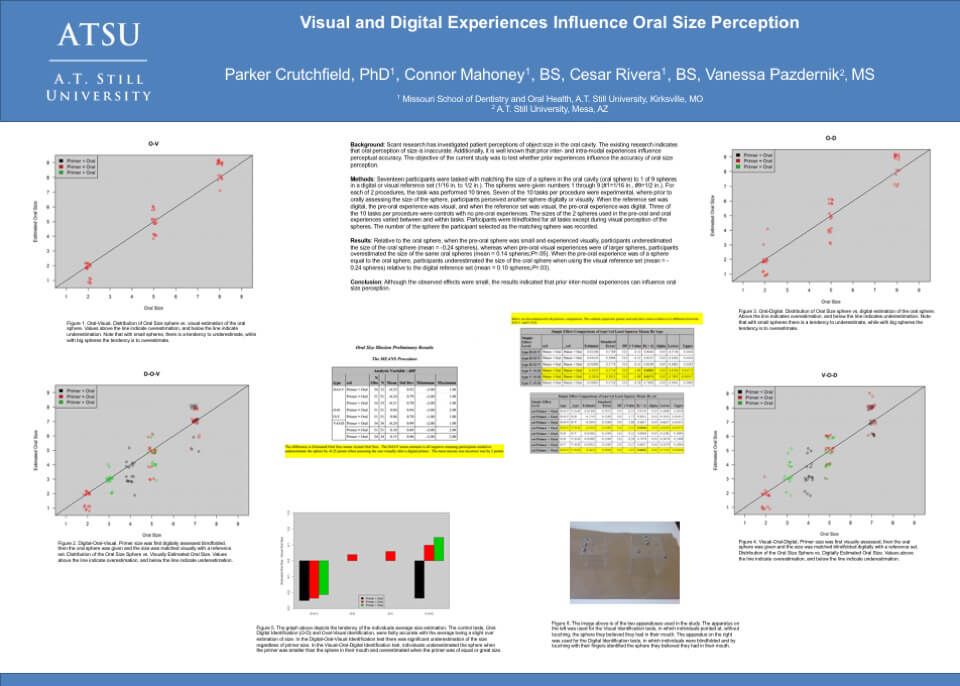Visual and Digital Experiences Influence Oral Size Perception
Contributors:
Parker Crutchfield, PhD1
Connor Mahoney1, BS
Cesar Rivera1, BS
Vanessa Pazdernik2, MS
Parker Crutchfield, PhD1
Connor Mahoney1, BS
Cesar Rivera1, BS
Vanessa Pazdernik2, MS
Participating Organizations:
Missouri School of Dentistry and Oral Health, A.T. Still University, Kirksville, MO
A.T. Still University, Mesa, AZ
Missouri School of Dentistry and Oral Health, A.T. Still University, Kirksville, MO
A.T. Still University, Mesa, AZ
Background
Scant research has investigated patient perceptions of object size in the oral cavity. The existing research indicates that oral perception of size is inaccurate. Additionally, it is well known that prior inter- and intra-modal experiences influence perceptual accuracy. The objective of the current study was to test whether prior experiences influence the accuracy of oral size perception.
Scant research has investigated patient perceptions of object size in the oral cavity. The existing research indicates that oral perception of size is inaccurate. Additionally, it is well known that prior inter- and intra-modal experiences influence perceptual accuracy. The objective of the current study was to test whether prior experiences influence the accuracy of oral size perception.
Methods
Seventeen participants were tasked with matching the size of a sphere in the oral cavity (oral sphere) to 1 of 9 spheres in a digital or visual reference set (1/16 in. to 1/2 in.). The spheres were given numbers 1 through 9 (#1=1/16 in., #9=1/2 in.). For each of 2 procedures, the task was performed 10 times. Seven of the 10 tasks per procedure were experimental, where prior to orally assessing the size of the sphere, participants perceived another sphere digitally or visually. When the reference set was digital, the pre-oral experience was visual, and when the reference set was visual, the pre-oral experience was digital. Three of the 10 tasks per procedure were controls with no pre-oral experiences. The sizes of the 2 spheres used in the pre-oral and oral experiences varied between and within tasks. Participants were blindfolded for all tasks except during visual perception of the spheres. The number of the sphere the participant selected as the matching sphere was recorded.
Seventeen participants were tasked with matching the size of a sphere in the oral cavity (oral sphere) to 1 of 9 spheres in a digital or visual reference set (1/16 in. to 1/2 in.). The spheres were given numbers 1 through 9 (#1=1/16 in., #9=1/2 in.). For each of 2 procedures, the task was performed 10 times. Seven of the 10 tasks per procedure were experimental, where prior to orally assessing the size of the sphere, participants perceived another sphere digitally or visually. When the reference set was digital, the pre-oral experience was visual, and when the reference set was visual, the pre-oral experience was digital. Three of the 10 tasks per procedure were controls with no pre-oral experiences. The sizes of the 2 spheres used in the pre-oral and oral experiences varied between and within tasks. Participants were blindfolded for all tasks except during visual perception of the spheres. The number of the sphere the participant selected as the matching sphere was recorded.
Results
Relative to the oral sphere, when the pre-oral sphere was small and experienced visually, participants underestimated the size of the oral sphere (mean = -0.24 spheres), whereas when pre-oral visual experiences were of larger spheres, participants overestimated the size of the same oral spheres (mean = 0.14 spheres;P=.05). When the pre-oral experience was of a sphere equal to the oral sphere, participants underestimated the size of the oral sphere when using the visual reference set (mean = -0.24 spheres) relative to the digital reference set (mean = 0.10 spheres;P=.03).
Relative to the oral sphere, when the pre-oral sphere was small and experienced visually, participants underestimated the size of the oral sphere (mean = -0.24 spheres), whereas when pre-oral visual experiences were of larger spheres, participants overestimated the size of the same oral spheres (mean = 0.14 spheres;P=.05). When the pre-oral experience was of a sphere equal to the oral sphere, participants underestimated the size of the oral sphere when using the visual reference set (mean = -0.24 spheres) relative to the digital reference set (mean = 0.10 spheres;P=.03).
Conclusion
Although the observed effects were small, the results indicated that prior inter-modal experiences can influence oral size perception.
Although the observed effects were small, the results indicated that prior inter-modal experiences can influence oral size perception.
